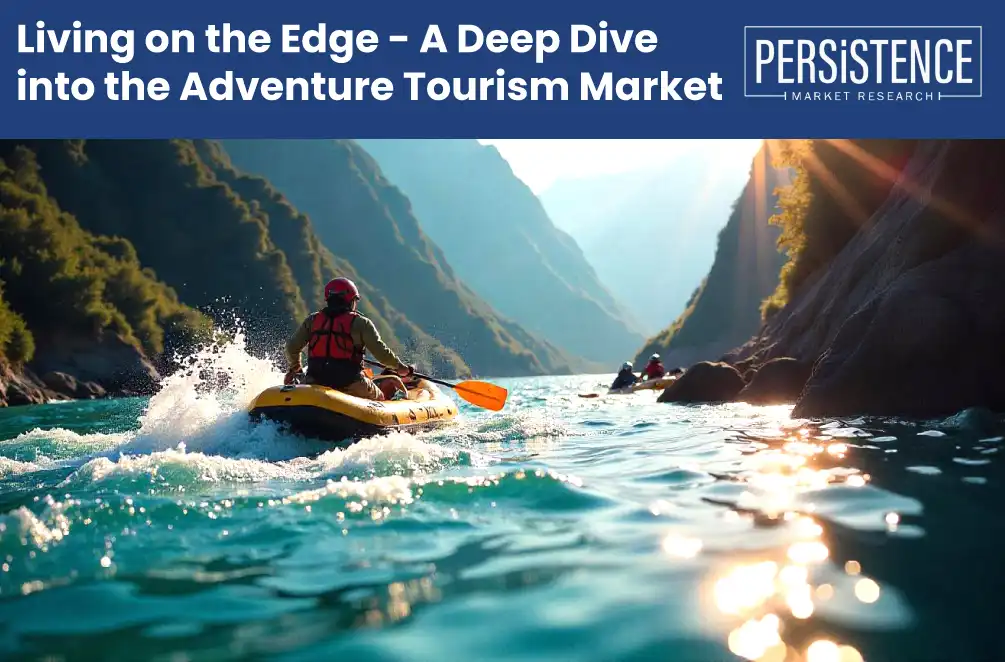- Blog
- Adventure Tourism Trends
Living on the Edge - A Deep Dive into the Adventure Tourism Market
Published On : 20 Jun 2025
As adventure tourism continues to rise, more travelers today seek exciting, hands-on experiences that connect them with nature and diverse cultures. The booming market is shaping how people explore the world. Its rapid growth helps local economies and drives the industry to continually innovate. From mountain peaks to deep oceans, adventure travel offers something for everyone who craves thrill and discovery.

Which are the biggest adventure tourism markets?
North America, Europe, and the Asia Pacific are the biggest adventure tourism markets. North America leads the way with a rising interest in hiking and mountain biking. In Europe, the UK adventure tourism industry is growing, offering scenic and cultural adventures. Asia Pacific too is flourishing with eco-tourism and extreme sports, especially in Thailand and New Zealand. The Australia adventure tourism market is also expanding, known for reef diving and outback expeditions.
What is driving the adventure tourism market forward?
High spending on leisure and travel play a big part as they allow people to spend more on experiences and outside ventures. Younger travelers, especially Millennials and Gen Z, prioritize experiences over material possessions since they are more interested in adventures that create lasting memories.
Social media also plays a major role. Sharing pictures and videos of adventure activities inspires peers to try similar adventures. Additionally, many governments also promote adventure tourism, providing an array of adventure activities through new infrastructure and innovation.
What are some of the specialized sectors for travelers to indulge in?
- Active adventure tourism includes activities that involve physical activity. People trek in the mountains, hike through forests, or bike challenging trails. Popular destinations are the Himalayas for trekking, the US National Parks for rock climbing, and the European Alps for skiing.
- Water adventures draw a lot of attention with scuba diving at the Great Barrier Reef, white-water rafting in Costa Rica, and surfing in Hawaii to attract thrill-seekers. The world’s oceans and lakes offer endless opportunities for water sports.
- Some travelers might prefer trips that mix adventure with local culture and ecology. Visits to Peru’s Machu Picchu, Tanzania’s safaris, or exploring tribes and ancestral fishing villages, these experiences often highlight sustainability and community involvement, making them a meaningful experience.
- For the daring ones, extreme sports gives the adrenaline rush with skydiving, bungee jumping, paragliding, and heli-skiing. Although riskier, advancements in safety tech and training have made these activities safer, appealing to thrill-seekers craving the ultimate adrenaline hit.
Are You Ready for the Next Trends in Adventure Tourism?
More travelers now want eco-friendly options. That means choosing providers that conserve nature and involve local communities. Industry groups promote responsible adventure travel through guidelines and certifications. Tech plays a big role in transforming adventures. Virtual reality (VR) and augmented reality (AR) let people sample experiences before booking. Mobile apps provide real-time info, maps, and safety tips. Drones and GPS help with navigation and capturing stunning footage. Wearable tech offers new ways to monitor health and safety during adventures.
Every traveler is different, and today’s adventurers want unique, tailor-made experiences. Companies now offer personalized adventure packages based on skill level, interests, and budgets. Whether it’s a solo mountain trek or a family-friendly eco-resort, customization makes adventures more appealing.
What are some of the major challenges?
Safety concerns and risk management are ongoing issues. Accidents damage the image and frighten away prospective customers. Another challenge is environmental protection, as more visitors affect the ecosystems. Popular destinations are overcrowded, which puts a strain on the environment as well as reduces the quality of the experience. More providers mean fierce competition, and geopolitical factors, like travel restrictions during pandemics or political unrest, can suddenly disrupt the flow of tourists. The COVID-19 pandemic has well demonstrated the vulnerability of international travel.
As adventure still awaits, are there any upcoming opportunities?
Emerging markets such as Africa, Southeast Asia, and South America are full of untapped adventure potential. Investing in sustainable eco-tourism and community projects could boost local economies while protecting nature.
- Digital marketing helps reach global audiences more effectively.
- Collaboration between local communities and adventure operators can foster sustainable growth. Offering eco-friendly, authentic experiences attracts conscientious travelers eager to make a difference with their travel dollars.
- The emergence of low-cost and direct flights further facilitates easy travel, reducing the time and cost barrier and allowing a steady influx of tourists to take part in the activities.
- The interest in budget-friendly adventure cruises is also increasing as the cruise providers offer various water adventure activities on board.
Conclusion
Demographics such as the Millennials and Gen Z, who value experience, will drive demand in the upcoming years. Technological innovations will keep transforming how people explore and enjoy adventures.
Focus on safety, incorporate new tech, and promote eco-friendly practices. It is also crucial to build trust with customers through safety certifications and responsible practices. In addition, adherence to the global agenda on environmental protection will make adventure tourism successful in the long run. Companies that change and provide unique, secure, and sustainable experiences will succeed. The future is bright for those ready to embrace change and prioritize responsible growth.
Industry Report

Request Report Sample
Your privacy is important to us; your data is secure
Contact Us
Latest Reports
-
Piezoresistive Pressure Sensor Market by Sensor Type (Absolute, Gauge, Differential, Sealed), Pressure Range (Low Pressure (<10 kPa), Medium Pressure (10 kPa – 1000 kPa), High Pressure (>1000 kPa)), End-Use Industry (Automotive & Transportation, Industrial Manufacturing, Healthcare, Aerospace & Defense, Electronics) and Regional Analysis for 2026-2033
-
Aquarium Accessories Market by Product Type (Filtration Items, Lights & Hoods, Temperature Control Systems, Others), End-User (Residential, Commercial), Distribution Channel (Online, Offline), and Regional Analysis for 2026-2033
-
Oxygen Therapy Market by Product Type (Compressed Oxygen, Concentrated Oxygen, Liquid Oxygen), Disease (Respiratory Disorder, Cardiovascular Disease, Sleep Apnea, Pneumonia), End-User (Hospitals, Home Healthcare, Clinics), and Regional Analysis for 2026-2033
-
Air Curtains Market by Product Type (Non‑Recirculating, Recirculating, Heated, Others), Airflow Capacity (Up to 500 m³/h, 500–1000 m³/h, 1000–1500 m³/h, Above 1500 m³/h), Application (Commercial, Industrial, Residential, Others), and Regional Analysis for 2026–2033
-
Personalized Stationery Market by Product type (Storage & Filling Products, Paper-Based Products, Drawing & Writing Instruments, Accessories, Bags, Others), Application (Educational Institutes, Corporate Offices, Personal Use, Hospitals, Others), and Regional Analysis for 2026–2033
